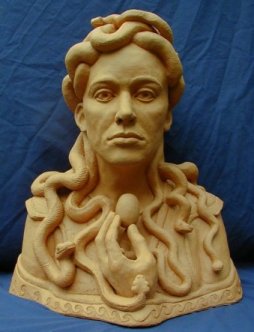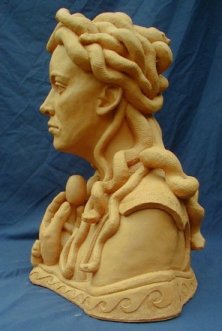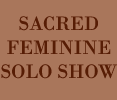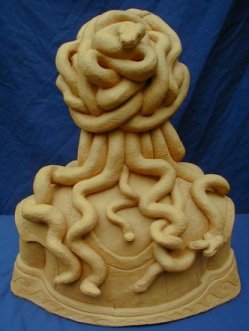
|
|


|
About the Piece
When the Greeks rewrote Medusas’ history, her
many faceted character was reduced to that of a terrifying gorgon who turned
men to stone. However, the more I read about her pre-Greek history, she
emerged as a three-dimensional character with a range of traits.
Medusa’s name comes from the same root word as medicine and measure. Her name derives from a Greek word meaning “to protect, to rule over.” (Babcock) The Gorgons, Medusa, Stheino and Euryale derive from the virtues of wisdom, strength and universality. It is thought that they were a trinity of the goddesses, and Pre-Hellenic mystics called the moon “the Gorgon’s head.” (Husain, pg.61) Barbara Walker (1983) writes extensively about Medusa; "Medusa was the goddess of the Libyan Amazons, and represented female wisdom. She was the Destroyer aspect of the Triple Goddess called Neith in Egypt, Ath-enna or Athene in North Africa. Her inscription at Sais, the capital of Egypt during the 7th century B.C., called her 'mother of all the gods, whom she bore before childbirth existed.' She was the past, present, and future: 'all that has been, that is, and that will be.' So famous was this description of her that Christians copied it for their god Jehovah (Revelation 1:8)." (p.629) With these ideas in mind, I made a sculpture that depicts Medusa as pre-Greek people might have perceived her, in this way revealing another aspect of her personality. Instead of her face being a mask of pain or a grimace, I tried to render a placid countenance with a simultaneous inward and outward gaze. The snakes on her head represent female wisdom, and are also an embodiment of the ideas and potential energy within each woman. Instead of these snakes writhing out of control, I have envisioned them as an energy that is held in check. Medusa the destroyer is also seen as a protector of the future, as embodied by the snake egg she tenderly holds in her hand. References: Babcock, Michael, Goddesses Knowledge Cards, Published by Pomegranate courtesy Susan Eleanor Boulet Trust.
For questions or comments about Cydra's art, please email: womansculpture@icloud.com
|



